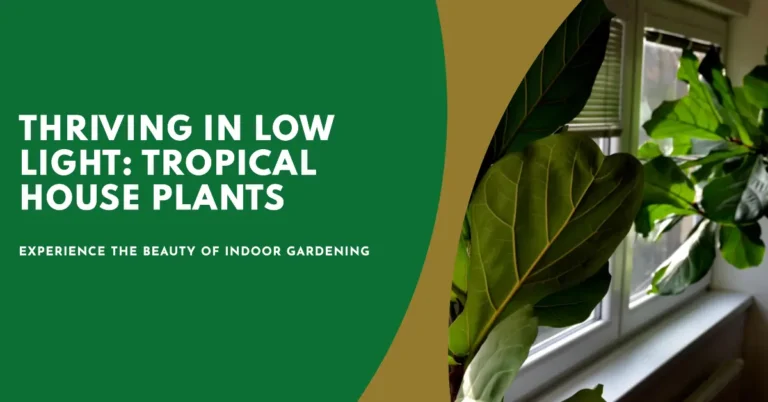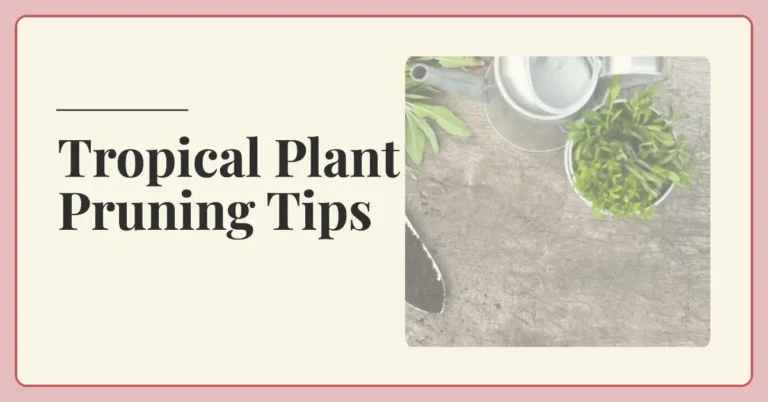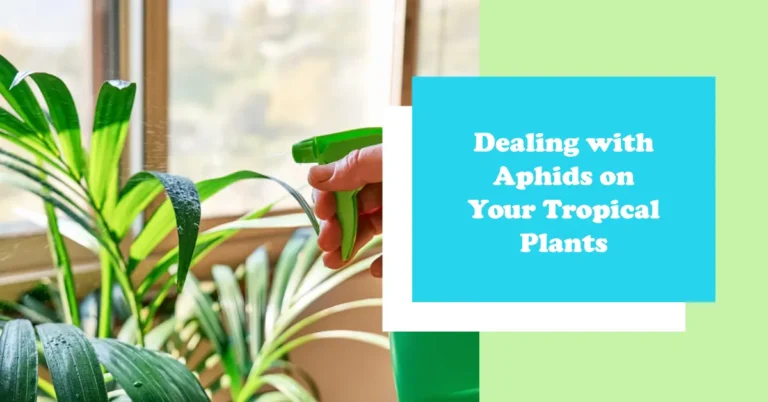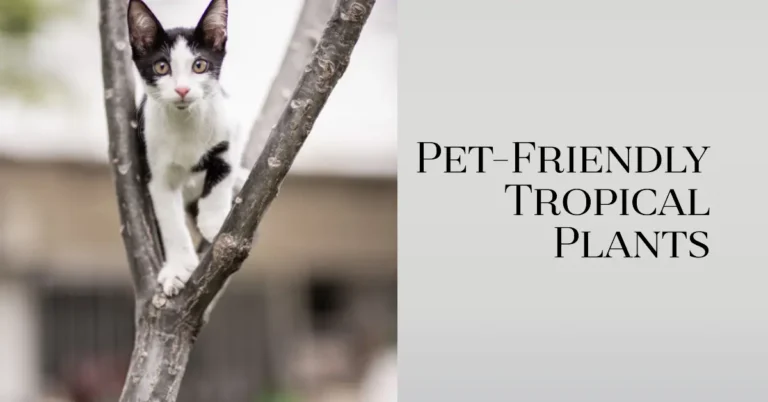Tropical Plant Pet Safety: Protecting Your Furry Friends from Harmful Flora
Understanding the symbiotic relationships that exist in nature between flora and fauna can often be fascinating and deeply enriching. It paints a picture of an intricate dance choreographed by nature herself, where each participant plays a pivotal role in sustaining our ecosystem. The journey from a tropical rainforest brimming with life to the coral reefs bustling with vivid colors tells tales of millions of years of co-evolution and intricate relationships.
However, this harmonious picture changes when we introduce domesticated pets into the equation. The topic of tropical plant pet safety thus becomes essential, especially for pet owners cultivating an indoor garden paradise.
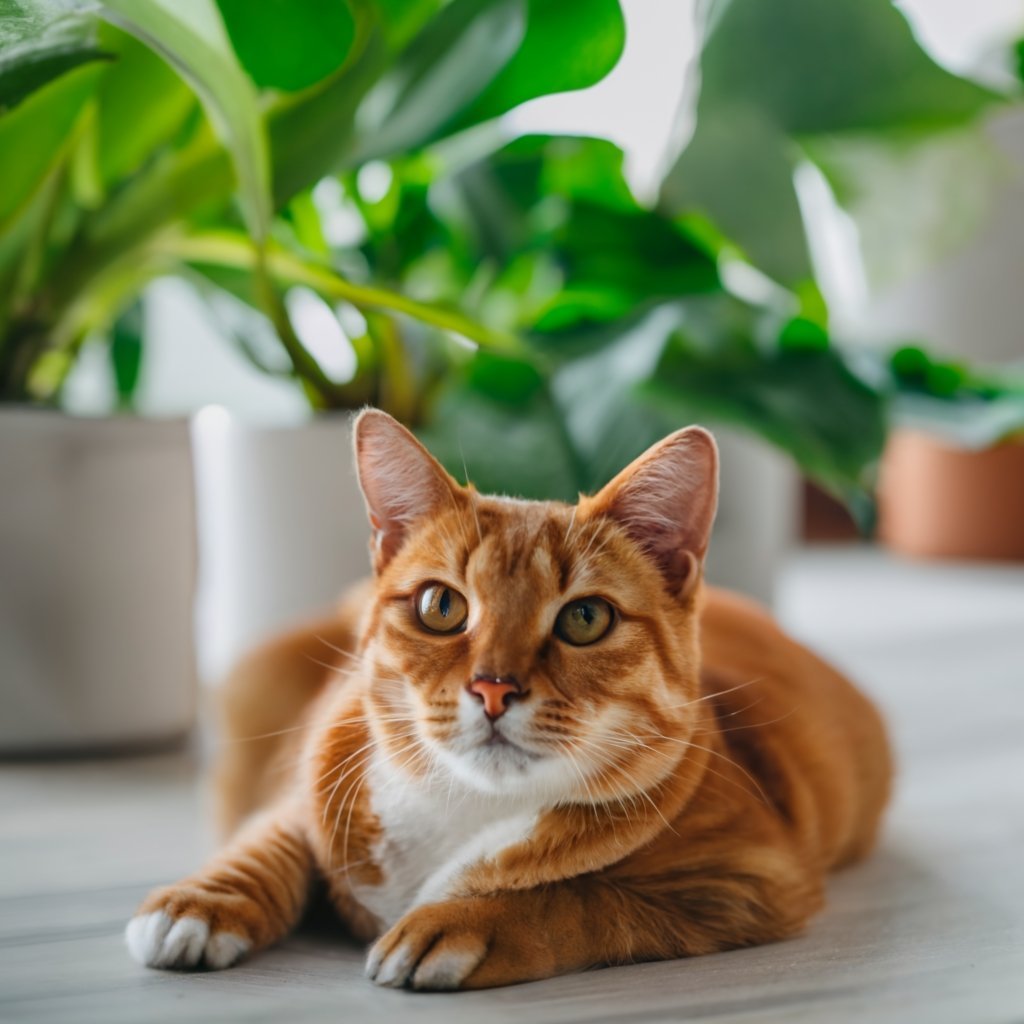
Why Tropical Plant Pet Safety is Crucial
Our curious and playful cherished pets may not realize the dangers lurking in those beautiful plants we nurture with love in our homes. Despite the plants bringing a slice of the tropical paradise indoors, they might harbor toxins detrimental to your pet’s health.
For instance, favorites like the Monstera Deliciosa or the Dieffenbachia are known to release calcium oxalates, causing severe discomfort and a burning sensation if chewed or ingested. The situation can be even more dire with plants like lilies, which can lead to kidney failure in cats within a short span of 36-72 hours if not treated promptly.
Protecting Your Pets while Maintaining an Indoor Jungle
While it might sound alarming, creating a safe and visually appealing indoor jungle that respects the principles of tropical plant pet safety is still very much achievable. Here are a few tips to foster a nurturing environment for both your plants and your pets:
- Research before purchasing: Before adding a new member to your plant family, research to ensure its non-toxic nature for your pets. Resources such as the ASPCA’s list of toxic and non-toxic plants can be a great starting point.
- Opt for pet-friendly plants: Plants like the Spider Plant or Boston Fern can be great non-toxic alternatives that keep your garden lush and your pets safe.
- Be vigilant about symptoms of poisoning: Recognizing early signs of poisoning can sometimes be a lifesaver. Learn the symptoms and have an action plan in place.
| Symptom | Action to Take |
|---|---|
| Drooling or vomiting | Consult a vet immediately |
| Sudden irritation or discomfort | Remove the source of irritation |
| Signs of weakness or lethargy | Offer comfort and monitor closely |
Concluding Thoughts
In the grand scheme of nurturing a bond between flora and fauna within the safety of our homes, the wellness of our fur babies takes precedence. Hence, the paradigm of tropical plant pet safety transcends being a choice and stands as an essential responsibility.
It might take a tad bit of extra effort and attention to details — but remember, it’s all for the vibrant vitality and joyful wiggles of your four-legged family member. Moreover, being a responsible pet parent means ensuring that the enchanting dance between flora and fauna continues harmoniously, even in the microcosm of your indoor garden.
Our love for lush greenery doesn’t have to diminish because we are pet owners; it just means we make conscious choices that prioritize safety. Because the joy of seeing our pets safe and happy is the most beautiful garden one can nurture.
Tropical Plant Pet Safety: What Pet Parents Need to Know
Are you in the loop about the potential hazards that common tropical plants pose to your cherished four-legged companions? It is time to immerse ourselves deeper in this critical topic. Leveraging tropical plant pet safety knowledge is a non-negotiable for responsible pet parenting.
A Closer Look at Common Culprits
The Sago Palm — an aesthetically pleasing yet perilous choice for households with pets. Every part of this plant harbors toxins potent enough to cause vomiting, diarrhea, and severe liver failure in your pets.
Joining the list is the Dieffenbachia or Dumb Cane. Despite its popular appeal, it’s a veritable trove of oxalate crystals, inducing severe mouth pain, drooling, and swallowing difficulties, potentially escalating to a life-threatening swelling of the throat.
Philodendrons may charm many indoor garden enthusiasts, yet, they pose a serious threat to our furry companions, causing a range of symptoms, including oral irritation, intense burning, and swelling of the lips, tongue, and throat, coupled with vomiting and swallowing difficulty.
So, a warm suggestion to all avid gardeners; Remember, tropical plant pet safety first!
Symptomatic of Plant Poisoning in Pets
Being watchful of sudden behavioral changes in your pet can be life-saving.
A deviation from their typical energetic demeanor to lethargy and unresponsiveness should raise alarms. While these signs might indicate distress, it is essential to investigate further before drawing conclusions.
Here’s a checklist of symptoms to keep an eye on:
- Loss of appetite
- Excessive drooling
- Vomiting or diarrhea
- Difficulty breathing
- Seizures or collapsing episodes
If you notice any of the above, consult a veterinarian immediately for a precise diagnosis and personalized treatment advice.


First Response to Toxic Plant Ingestion
In the unfortunate event of toxic plant ingestion, stay calm and initiate the following steps promptly:
- Identify the Plant: Document the plant ingested using a picture or sample to aid medical advice.
- Clean your Pet: Remove remnants from their mouth and rinse with fresh water to prevent further ingestion.
- Emergency Contact: Have the vet’s number accessible and seek immediate professional help. Be prepared to provide comprehensive details of the incident to facilitate swift diagnosis.
Remember, with matters concerning tropical plant pet safety, every moment counts!
A Guide to Keeping Pets Safe from Hazardous Plants
Knowledge is your first line of defense. Commence with identifying the toxic and non-toxic tropical plants in your home. For this, resources such as the comprehensive list provided by ASPCA can be enormously helpful.
Next, let’s delve into preventative measures:
- Physical Barriers: Employ physical barriers like high shelves, plant stands, or fencing to keep pets away from hazardous plants.
- Training: Utilize positive reinforcement techniques to train your pets to avoid these plants.
Let’s make a pact to prioritize tropical plant pet safety, fostering a secure environment for our adored furry family members. Remember, your vigilance and education in this regard can be a lifesaver.
Non-Toxic Tropical Plants Safe for Pets
Let’s dive into the world of pet-friendly tropical plants, shall we? First up on our list is the Areca Palm. This plant adds a splash of lush greenery to your home and is also non-toxic for cats and dogs. Plus, they are excellent air purifiers – an added bonus! They require bright, indirect light and regular watering, so don’t forget about them.
Next in line is the Spider Plant. These little guys are hardy and easy to care for, making them perfect for those who may not have been blessed with a green thumb. The best part? They’re completely safe if your curious fur baby decides to take a nibble or two! Just remember that these plants prefer well-draining soil and thrive in cooler temperatures.
Another great option would be Boston ferns which bring an element of softness with their delicate fronds. They’re ideal for hanging baskets, keeping them out of reach from pets while adding height variation to your indoor jungle aesthetic. Despite being non-toxic, it’s always good practice to discourage chewing on any houseplants as this can sometimes lead to mild gastrointestinal upset in pets due to unfamiliar textures or flavors.
Creating a Pet-Friendly Indoor Jungle with Safe Tropical Plants
Creating a safe, pet-friendly indoor jungle starts with selecting the right plants. Some tropical plants are non-toxic and perfectly safe for our furry friends. Spider Plants, Areca Palms, Boston Ferns, or even Orchids can add an exotic touch to your home without posing any threat to your pets. These plants purify the air and bring in a sense of calmness and tranquility.
Now that you’ve ready your list of safe plants, it’s time to get creative with placement. Pets are naturally curious creatures who love exploring their surroundings. Hence, placing these green beauties at strategic locations is key – perhaps floating shelves or hanging pots from ceilings could be great options! This way, they serve as beautiful décor while staying out of reach from those mischievous paws!
However, just having non-toxic plants isn’t enough – we need to ensure they’re well-maintained too! Regularly check for pests lurking around in plant pots which might cause discomfort or harm if ingested by pets accidentally.
Also, ensure there’s no stagnant water left in saucers underneath the pots – this could become a breeding ground for mosquitoes, posing another health risk altogether! So go ahead and create your indoor oasis keeping these points in mind; after all, nothing beats having a lush green space filled with happy pets prancing around.
Professional Advice: Vets on Tropical Plants and Pets
Many pet owners often wonder about the safety of their furry friends around tropical plants. To shed some light on this topic, we reached out to several veterinarians for their insights and professional advice. Dr. Sarah Thompson, a renowned veterinarian with over 20 years of experience in small animal practice, emphasized the importance of knowing which plants are toxic to pets. “There’s an extensive list of tropical plants that could potentially harm your pets if ingested,” she said. “These include popular houseplants like Dieffenbachia (Dumb Cane), Sago Palm, and certain types of Philodendrons.”
Dr. Thompson also mentioned that symptoms can vary depending on the type of plant consumed by your pet and how much they’ve eaten. Some common signs may include drooling, vomiting, diarrhea, or even more severe reactions such as seizures or loss of consciousness in extreme cases.” It’s crucial for pet parents to be vigilant,” advises Dr.Thompson.
Another expert we spoke with was Dr.James Peterson, who has been practicing veterinary medicine for over 15 years specializing in exotic animals including reptiles and birds. He shared his thoughts on non-toxic alternatives for those still wishing to maintain an indoor jungle vibe at home without endangering their beloved pets.”Spider Plants are great! They’re not only safe but also easy to care for,” he suggested enthusiastically.” Boston Ferns too!” He added that while having these safer options around is essential,it is equally important to train our pets from early stages, not try chewing on them either way.
A Detailed Guide on Plant and Pet Coexistence
Let’s dive right into it, shall we? Creating a harmonious environment for your pets and plants requires understanding the needs of both. Each pet species has unique characteristics and behaviors that can influence their interaction with tropical plants. For instance, cats are known to be curious creatures who love exploring their surroundings, which may include nibbling on leaves or digging in soil pots. On the other hand, dogs might not show as much interest in your greenery unless they’re teething puppies looking for something to chew on.
Now let’s talk about plants! Like our furry friends, each plant variety also comes with its own set of requirements – sunlight exposure, water frequency, humidity levels, etc., but what really matters here is whether they contain toxins harmful to pets or not. Some popular indoor tropical plants like Dieffenbachia (Dumb Cane), Philodendrons, and ZZ Plants are known to contain calcium oxalate crystals which, when ingested, can cause symptoms like drooling, vomiting or difficulty swallowing in pets.
So how do you create a safe coexistence between these two? The key is education and precautionary measures. Start by researching any new plant you wish to bring home; understand its toxicity level and the potential harm it could cause your pet if ingested or touched. Place potentially harmful plants out of reach of your pets – hanging them from ceiling hooks or placing them on high shelves can work wonders! Also, consider training your pets (especially young ones) to avoid chewing on foliage – using deterrent sprays designed for this purpose can help reinforce this behavior over time.
The Role of Training in Ensuring Pet Safety Around Plants
Training your pets to stay away from certain plants is essential to ensuring their safety. This can be achieved through various ways, such as using positive reinforcement techniques or setting up physical barriers around the toxic plants. Positive reinforcement involves rewarding your pet for good behavior, like staying away from a particular plant, with treats or praise. Physical barriers on the other hand, could include placing the dangerous plants in areas that are inaccessible to your pets.
It doesn’t stop at just training, though; you also need to keep an eye out and monitor their interaction with flora closely, especially during the initial stages of training. Pets are naturally curious creatures and might still attempt to get close to these forbidden greens despite being trained not to. If you notice any unusual behavior, such as excessive drooling, vomiting, diarrhea, or loss of appetite after they have been near a tropical plant, it’s best to consult a vet immediately.
A consistent routine will help reinforce this learning over time. For instance, if you’ve trained your dog not to approach a specific type of plant while outside in the garden by redirecting its attention towards toys or other safe distractions whenever it gets too close, make sure this practice is maintained even when indoors where there might be similar looking houseplants present. The key here lies in consistency and patience – remember, every pet learns at its own pace!
Tales from Pet Owners: Experiences with Tropical Plants and Pets
Carol, a proud pet parent of two mischievous kittens, shared her experience with us. She had recently added exotic tropical plants to her indoor garden without realizing their potential toxicity to pets. The kittens found the new additions quite fascinating and decided to have a taste test. It was not long before they started showing signs of discomfort – vomiting and excessive drooling were the first indicators that something was wrong.
In another instance, an avid dog lover, Jim recalled how his golden retriever developed skin rashes after rolling around in his backyard filled with tropical flora. He initially dismissed it as just an allergic reaction but when the symptoms persisted for over a week, he took him to the vet. After thorough examination and tests, it was confirmed that his pooch had been exposed to toxic plants which caused dermatitis.
On a more positive note, there’s Lisa, who managed to create a safe haven for her pet parrot by carefully selecting non-toxic tropical plants for her sunroom-turned-aviary. She did extensive research on each plant she intended to buy and even consulted with professionals before making any purchases. Her efforts paid off as her feathered friend thrived in its new environment without any health issues related to plant exposure.
FAQs
What is the relationship between flora and fauna in the context of pets and tropical plants?
The relationship between flora (plants) and fauna (animals) can be beneficial or potentially harmful. Some tropical plants provide a natural habitat and food source for pets, while others can be toxic if ingested or touched.
Why is it important to keep pets safe around tropical plants?
It’s crucial because some tropical plants are toxic to pets and can cause serious health issues, like skin irritations, digestive problems, or even death. As pet owners, it’s our responsibility to ensure our pets’ environments are safe.
What are some common tropical plants that are toxic to pets?
Certain tropical plants like Sago Palm, Oleander, and Peace Lily are known to be toxic to pets. If consumed, they can cause vomiting, diarrhea, and other more serious health problems.
How can I recognize signs of plant poisoning in my pet?
Signs of plant poisoning can vary but watch for symptoms like excessive drooling, vomiting, diarrhea, lack of appetite, lethargy, or abnormal behavior. Contact your vet immediately if you notice any of these symptoms and suspect plant poisoning.
What first aid can I provide if my pet gets exposed to a toxic plant?
Remove any plant particles from your pet’s mouth or fur if possible. Do not induce vomiting unless directed by a vet. Keep your pet hydrated and comfortable, and contact your vet immediately.
How can I train my pet to stay away from harmful plants?
Training can include positive reinforcement techniques like rewarding your pet for avoiding the plants, using deterrents like bitter sprays on the plants, or creating physical barriers around the plants.
Can you name some non-toxic tropical plants that are safe for pets?
Absolutely! Some pet-safe tropical plants include Spider plants, Areca palms, Boston ferns, and Bamboo palms. Always double-check with a professional before introducing a new plant into your pet’s environment.
Is it possible to create a safe indoor jungle for my pet?
Of course! You can create a lush indoor jungle using pet-safe plants. It’s all about choosing the right plants and setting up your space in a way that’s fun for you and safe for your pet.
What professional advice do vets give about tropical plants and pets?
Vets generally advise pet owners to be aware of the plants they bring into their homes, keep toxic plants out of reach, and monitor their pets for any signs of plant poisoning. Regular vet check-ups are also recommended.
Can you share some experiences of pet owners with tropical plants?
Sure, many pet owners have shared their good and bad experiences. Some have created beautiful indoor jungles for their pets to enjoy, while others have learned the hard way about the dangers of certain plants. The key takeaway is to stay informed and proactive about your pet’s safety.


